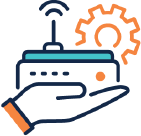
Malicious Attacks | A Deep Dive
Every 39 seconds, a malicious attack happens. A malicious attack is a common cyberattack that damages, corrupts, or misuses your system through illegitimate actions. These actions can take advantage of weaknesses in your hardware and software and can be executed through ransomware, spyware, viruses, bots, etc. These are usually found attached to emails, embedded in links, hidden in ads, and strategically placed on various websites to steal data, passwords, financial information, and so much more. Let’s dive into some of the most common types of malicious attacks below:
Ransomware

Have you ever heard those horror stories about having to pay a ransom by a specific deadline, and if not paid, your data will get deleted or exposed by the hackers? After a lot of data and money loss, ransomware attacks are the most lucrative type of malicious attack. Ransomware scrambles a device’s data and once encrypted, the hacker will hold the data for ransom until they are paid to release it. We know it sounds scary, but there are ways to combat this attack. Some best practices are to ensure that your team understands proper cyber etiquette by avoiding clicking on malicious links, emails, ads, SMS-messaging, etc. Your IT (Information Technology) support should also be actively involved with ongoing security updates, threat detection, and data storage. This should allow you to get your system back up and running, sometimes even without paying the ransom.
Spyware

Another common type of malicious attack cybercriminals use is spyware. Spyware tracks activity made by the user by documenting keystrokes. Think about how much you type a day; more specifically, how many times you enter passwords, usernames, and other personal data. It’s a lot! Over 3 billion passwords and pieces of personal data are compromised or taken every year through malware. We suggest using a random password generator (ex. 1Password) to have different passwords for different applications, as well as using anti-tracking browser extensions. To this day, the most common password is 123456 – so make sure your password is not this obvious nor easy to crack. And of course, talk to your IT support about the levels of security they provide to detect and prevent these forms of attacks.
Viruses

The third common type we’ll cover are viruses. When your system becomes infected by a virus, the virus can begin to spread from one system to another – encrypting, corrupting, moving, and deleting your data. This is a common type of attack, as phishing contributes to over 37 percent of all malicious attacks against businesses. Many viruses can pose as something legitimate – like a link in an email, a file, or a picture – but it is in fact malicious. Having an IT service provider can be helpful in combatting these viruses as they would be able to run daily security scans and ensure that your antivirus solutions are up to date. If you have any questions about something you have received, especially before downloading that shady piece of software, we strongly encourage you to consider asking an IT service provider – if they believe it is from a reputable source or not.
Bots

There are many malicious attacks out there, but the last common type we’ll cover are bots. A bot is a program that will complete a task without requiring any interaction from the user. Bots are capable of massive attacks as they can be controlled and used by hackers, often without the user even knowing that it’s there. You have probably noticed that most electronic forms now ask if you’re a robot? This is called CAPTCHA! CAPTCHA can fight against the bots by not allowing them to overwhelm your system. Consider using tools like this to identify and separate the good traffic from the bad.
Ultimately…
The common denominator for each type of attack is human error. Human error is the most popular cause of security breaches. Many malicious attacks are the result of getting a user to actively click a link, download a file, or run a program. For many organizations without committed IT support, this is difficult to manage. Staying on top of threat detection and ahead of malware threats can make or break your business!
An IT team can defend your organization against these threats through implementing ongoing security solutions, scanning & actively detecting intrusions, and protecting against these threats in real-time. Consider asking your IT support what they provide when it comes to data backup, security solutions, object storage, disaster recovery, phishing and other cyber security awareness training.
If you don’t currently have a committed IT service provider, we strongly encourage you to find one that suits your business needs. Not sure where to start? Our DTC IT Experts would be more than happy to help answer any questions you may have about your business or practice IT infrastructure! Feel free to call us at 410-877-3625 or send us an email to AskUs@dtctoday.com.
Remember: every 39 seconds, a malicious attack happens. Don’t let that next attack be on you!
Contributed by DTC staff
Related Articles:
- How the First Cyber War (2007) Set the Stage for Today’s Cyber Financial Attacks
- Right of BOOM: The Aftermath of a Cyberattack
- If You Suspect Deceit, Hit DELETE. Phishing Attacks Explained